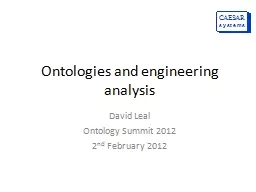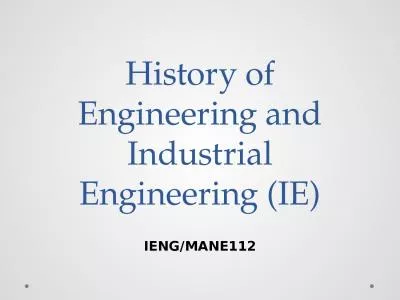PPT-Ontologies and engineering analysis
Author : lindy-dunigan | Published Date : 2016-11-03
David Leal Ontology Summit 2012 2 nd February 2012 What is engineering analysis Analysts look at the physics systems engineers want something to do X designers
Presentation Embed Code
Download Presentation
Download Presentation The PPT/PDF document "Ontologies and engineering analysis" is the property of its rightful owner. Permission is granted to download and print the materials on this website for personal, non-commercial use only, and to display it on your personal computer provided you do not modify the materials and that you retain all copyright notices contained in the materials. By downloading content from our website, you accept the terms of this agreement.
Ontologies and engineering analysis: Transcript
David Leal Ontology Summit 2012 2 nd February 2012 What is engineering analysis Analysts look at the physics systems engineers want something to do X designers propose a way of doing X. . Neda Alipanah. 22 October 2012. Content. Why . Ontologies. ?. Machine Process able Knowledge. Knowledge Exchange. Big Data. Relevant Technologies. Layered Architecture. Building Tools and Visualization . OGMS, IDO, and VO. (Orlando Presentation, 2/8/2013). http://. ncorwiki.buffalo.edu/index.php/CTSA_Ontology_Workshop. Yongqun “Oliver” He. University . of Michigan Medical School. Ann Arbor, MI 48109. Jeff Z. Pan, . Yuan Ren. , Nophadol Jekjantuk, and Jhonatan Garcia. University of Aberdeen, UK. ORE2013. The FMA ontology. The Foundational Model of Anatomy ontology is “an evolving computer-based knowledge source for biomedical informatics”. Jake Blanchard. Fall 2010. Uncertainty Analysis for Engineers. 1. Instructor. Jake Blanchard. Engineering Physics. 143 Engineering Research Building. blanchard@engr.wisc.edu. Uncertainty Analysis for Engineers. Barry Smith. August 26, 2013. Continuant. Occurrent. Independent. Continuant. Dependent. Continuant. Basic Formal Ontology . 2. Anatomy Ontology. (FMA*, CARO). Environment . Ontology. (EnvO). Infectious Disease Ontology. Barry Smith. New York Times response. US DoD Civil Affairs strategy for non-classified information sharing . 7. DoD annual budget $800 billion. IT budget for HR alone: $6 billion. http://goo.gl/znpWk. PHI 548 / BMI 508. Werner . Ceusters. . and Barry Smith. 1. . Lecture 1. Introduction to Ontology. . Barry Smith. Schedule. Ontology Timeline. The Special Role of the Gene Ontology. Open Biomedical Ontologies (OBO) Foundry. Amanda Hicks. University of Florida. aehicks@ufl.edu. HealthInsight. Workshop, Oslo, Norway. 20 May . 2016. Overview. Ontologies versus . w. ordnets. Inter-Lingual Index. Future work to map National Cancer Institute Thesaurus to the Collaborative Inter-Lingual Index. Mohammed Alshayeb. March 3. rd. , 2011. Outlines. Theoretical Foundations of . Ontologies. Principle for the Design of . Ontologies. Ontology Language. Selection of Ontology Projects. What is Ontology? . Melissa Haendel and Jim . Balhoff. INCF taskforce cross program meeting. Stockholm, Aug. 30, 2013. All about ontologies. What is an ontology?. A little logic. Upper ontologies. OWL and RDF. Data integration . The Desired Brand Effect Stand Out in a Saturated Market with a Timeless Brand IENG/MANE112. 1. Engineering. 1.1 The origin of the word “engineering. ”. . Latin . ingenium. = . clever invention. Why a Latin word? . English language = . Saxonian. (German) + Latin + Viking (Norwegian) + . between terminologies, ontologies, and information models. Stefan . Schulz. a . Daniel Schober. a. Christel Daniel. b,c. Marie-Christine . Jaulent. b. . . a. Institute of Medical Biometry and. Medical Informatics, University . ‘ENGINEERING STRATEGIES FOR HANDLING COVID-19 FOR ENVIRONMENTAL HEALTH AND ECONOMIC SUSTAINABILITY’. PREPARED BY. CHINWENDU CHIBUOKEM ONYEDIKACHI. 17/ENG02/016. COMPUTER ENGINEERING. COVID 19 (CORONA VIRUS DISEASE –19).
Download Document
Here is the link to download the presentation.
"Ontologies and engineering analysis"The content belongs to its owner. You may download and print it for personal use, without modification, and keep all copyright notices. By downloading, you agree to these terms.
Related Documents











![[FREE]-Ontologies with Python: Programming OWL 2.0 Ontologies with Python and Owlready2](https://thumbs.docslides.com/974946/free-ontologies-with-python-programming-owl-2-0-ontologies-with-python-and-owlready2.jpg)


